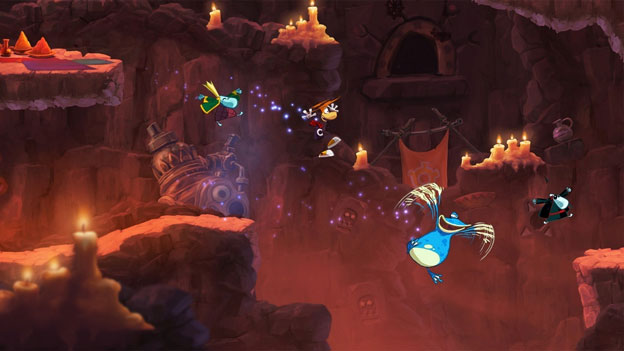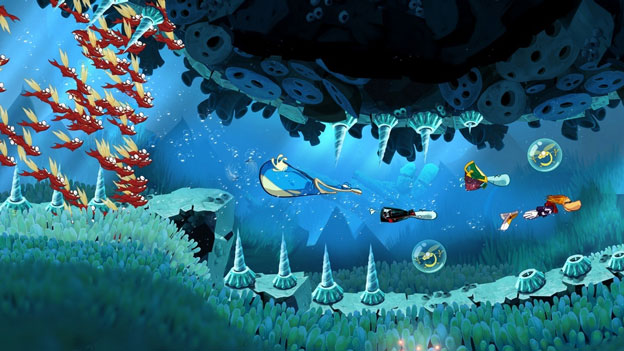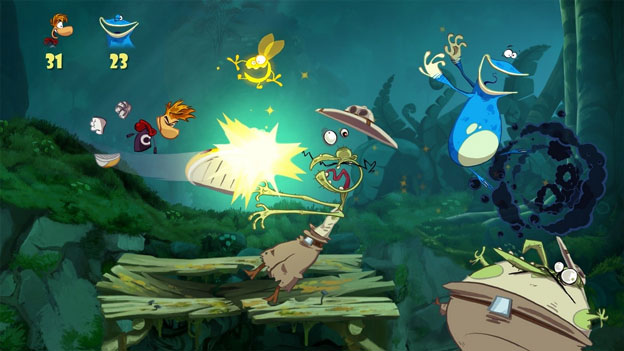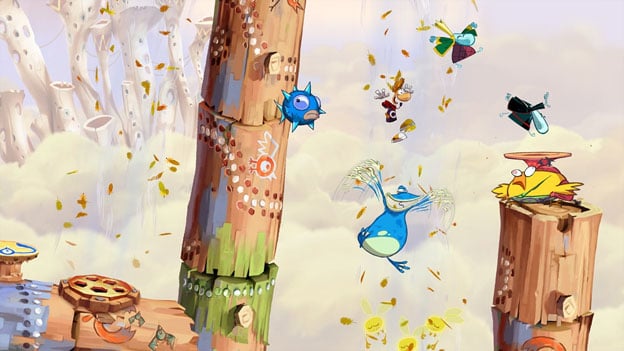Quick And Quirky Platforming Genius
Why, oh why, did Ubisoft release Rayman Origins around the same time as juggernauts like Modern Warfare 3, Skyrim, Super Mario 3D Land, and Zelda: Skyward Sword? With those giants taking up store shelves, the box featuring two quirky characters leaping atop a pile of angry spined creatures is likely to be ignored. The tragedy is that Rayman Origins is a gem that doesn’t deserve such treatment, particularly from anybody who feels that modern platformers are far too easy.
Rayman Origins sets its tone immediately, as Rayman’s quest is set off when the local Livid Dead object to the snoring of Rayman and his funny-looking friends. They retaliate by shaking up the world, sending Rayman on a two-dimensional platforming quest to put things back together. The story is generally unimportant; like all platformers, the game is all about traversing levels and reaching goals that give the player access to new areas. Still, the wild and wacky world that Rayman inhabits is quite charming, from the glowing, singing lums that Rayman collects in the levels to the grumpy, spiky enemies that he must avoid or punch out.

The atmosphere created by the game’s excellent audio and visual design is immediately striking. The two-dimensional HD graphics are gorgeous, and the animations create a world bursting with both life and insanity. From the colorful characters to the weird and wonderful levels, Rayman Origins has the feel of the old Warner Brothers cartoons brought into the world of Adult Swim. When struck, enemies turn into giant and sometimes hilarious-looking bubbles, which can then be popped for extra points. Players will be popping these enemies in bizarre settings like a world full of sentient food and utensils and an ocean stocked with singing fish. The sound effects are delightfully cartoonish as well. The music is very well done and gets better as the game goes on, with only a few tracks that could draw spousal aggro if repeated too often.
The game doesn’t do very much handholding, so it can take a few minutes to become oriented and figure out how to get things going. Once off and running, however, players will see that Rayman Origins is an old school platformer with modern sensibilities. Rayman (or whichever of the other characters the player chooses to portray) is rather fragile, and a single blow from an enemy or stumble off the level blows him up and sends him back to the beginning of the area. He can pick up a single heart item at a time and withstand a single hit, but that won’t save him from the many pits or crushing objects he can encounter. Fortunately, most of the levels are broken up into bite-sized chunks, so there’s not generally a ton of backtracking to do, plus players will get the option to skip a level after dying about ten times in a particular area. Still, this decidedly retro design choice can be annoying when the player is attempting to master a difficult segment near the end of the area. It tends to discourage exploration the first time through a level, as the player has to weigh whether chasing after an optional collectible is worth possible death.

The levels are designed to be run multiple times, anyway. Each level has a “medallion” associated with it, and players fill the medallions by completing various goals, like rescuing creatures and gathering up a certain portion of the collectibles. Once a level has been completed, characters can access a speed run challenge, and can also return to the level to attempt to meet any goals that weren’t met the first time through. Meeting the second collectible goal is highly unlikely for a first runthrough of a level, as the player will need to get to know a level very well to collect all the little floating lums that pop up before they float off the top of the screen. Hardcore platforming fans will love attempting to fill out the medallions, for it involves truly mastering the levels, which is a very challenging prospect.
There’s a huge diversity found in the generous number of levels the game offers. During the first half of the game, the player receives one new “power” in every world. These powers include the ability to hit enemies, to hover in the air, to change size, to dive, and to run up walls. After all these powers have been unlocked, a new set of worlds becomes available with levels that test the player’s mastery of these powers in new and interesting ways. This keeps the game feeling fresh throughout. There are also some shoot-em-up levels in which Rayman hops onto a giant mosquito that can shoot bullets and suck in/spit out enemies. These levels are very well done and were some of my personal favorites. Finally, there are special challenges in which Rayman must chase down a fleeing treasure chest, which are alternately fun and frustrating.

There are many moments of platforming magic to be found in Rayman Origins, from performing a graceful underwater ballet with electrified jellyfish to leaping up a set of perpetually falling furniture. Some of the game’s faster-moving segments feel a bit like a good Sonic game, with Rayman making split-second decisions as he sprints across dangerous terrain. It feels great to string together just the right combination of jumps and kicks to make it through the game’s tougher segments. Rayman controls excellently, so deaths are almost always understandable and don’t usually feel unfair. There are a few quirks; wall-running takes a bit of getting used to and there are a few platforms that are far too easy to overshoot. Overall, though, the player feels in control despite the challenge level, and that’s where the magic happens.
Multiplayer gameplay occurs in the main levels of the game, and is the way to go for less hardcore players. Up to four people can play at once, though the result is a bit of a different feeling than the elegant single-player game evokes. There’s a lot more push-and-pull involved. Though players are able to help keep each other alive, they can also accidentally (or purposefully) knock each other around. Still, it’s an easy drop-in, drop-out system, so it’s worth giving a spin.

Rayman’s spell does break occasionally. The checkpoint system disappears during the speed run challenges that are a part of every medallion. That means one hit or slip and you’re back to the beginning of the level, which is likely to be frustrating to all but the most hardcore players. The controls can also be a bit hard on the hands. Between holding down the hover button and pressing in the trigger that allows for wall-running, it’s advisable to take regular breaks from the game in order to avoid hand cramps, especially if you have stupidly small hands like I do. Finally, more casual players may be disappointed to learn that later in the game, access to bosses requires having filled a certain number of medallion slots, meaning that a certain number of “optional” challenges must be completed in order to finish the main story of the game.
Rayman Origins has received just short of a “Must Buy” rating due to the design decisions that may frustrate some players. Hardcore platforming fans, however, absolutely must pick up this title. It’s some of the most interesting and challenging platforming to come along in some time, and the excellent audiovisual design is icing on the cake. Platforming fans who felt that Super Mario 3D land was just a bit too short will find Rayman Origins to be refreshingly lengthy and more challenging throughout. More casual players will enjoy the amazing world and the diversity of levels available, although they may not make it to the end of the game. I implore anybody who enjoys traditional two-dimensional platformers to put down their guns and swords at some point this holiday season and grab a copy of Rayman Origins. You’ll be glad you did.
RATING OUT OF 5 RATING DESCRIPTION 4.8 Graphics
Rayman Origins features a beautifully made, imaginative 2D world that looks gorgeous in HD. 4.5 Control
In general, Rayman controls like a dream, with a bit too much button holding as the only complaint. 4.2 Music / Sound FX / Voice Acting
Sound effects are delightfully wacky, and the soundtrack is appropriately weird and wonderful. 4.3 Play Value
There’s a ton of content here; enough that the forced repetition of old levels could have been avoided. 4.4 Overall Rating – Great
Not an average. See Rating legend below for a final score breakdown.
| Review Rating Legend | |||
|---|---|---|---|
| 0.1 – 1.9 = Avoid | 2.5 – 2.9 = Average | 3.5 – 3.9 = Good | 4.5 – 4.9 = Must Buy |
| 2.0 – 2.4 = Poor | 3.0 – 3.4 = Fair | 4.0 – 4.4 = Great | 5.0 = The Best |
Game Features:
